Behringer MODEL D Authentic Analog Synthesizer with 3 VCOs, Ladder Filter, LFO and Eurorack Forma
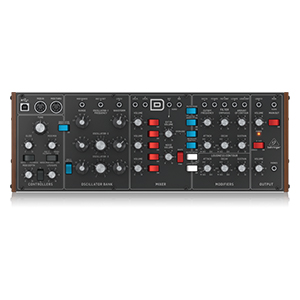

MODEL D
Authentic Analog Synthesizer with 3 VCOs, Ladder Filter, LFO and Eurorack Format
- Amazing analog synthesizer with triple VCO design allows for insanely fat music creation
- Authentic reproduction of original “D Type†circuitry with matched transistors and JFETs
- Ultra-high precision 0.1% Thin Film resistors and Polyphenylene Sulphide capacitors
- 5 variable oscillator shapes with variable pulse widths for ultimate sounds
- Classic 24 dB ladder filter with resonance for legendary sound performance
MODEL D
| | | | |
|---|---|---|---|
A Passion for KeyboardsOur founder, Uli Behringer has a deep passion for keyboards. Born in the small town of Baden, Switzerland in 1961, Uli grew up in a musical family where his mother taught him to play the piano at the tender age of four. His father was a scientist who built a massive organ in the family home and taught the young lad all about electronics. So at the age of 17, Behringer built his first synthesizer – the UB-1. Later, while attending college to seek a degree in audio engineering, Uli put his electronics knowledge to use, building his own equalizers and signal processors to fill the gap left by the university’s inability to provide enough proper studio gear. Word soon spread about how good his products were, and he began building gear for his friends – the Behringer legacy had begun. The rest, as they say, is history… | MODEL DThe 1970s spawned the first truly portable analog synthesizer, and while it was quickly adopted by lots of renowned musical artists including Jan Hammer, Chick Corea, Rick Wakeman, Jean-Michel Jarre, Isao Tomita and Keith Emerson to name a few, it was somewhat temperamental and very expensive. An ultra-affordable homage to that iconic synthesizer, with all the features of the original and then some, the Behringer MODEL D lets you conjure up virtually any monophonic sound imaginable with incredible finesse and ease. The pure analog signal path is based on authentic VCO, VCF, VCA and ladder filter designs in conjunction with a dedicated and fully analog triangle/ square wave LFO. And when it comes to protection and convenience, the MODEL D can even be mounted in a standard Eurorack, making it ideal for the studio and/or the road. Owning a MODEL D is like having your own personal time machine, enabling you to freely embrace the past – or shape the future! | True to the OriginalGreat care has been taken in designing the MODEL D including the true to the original “D Type†circuitry with its matched transistors and JFETs, ultra-high precision 0.1% thin film resistors and polyphenylene sulphide capacitors. This highly-focused attention to detail is what gives the MODEL D its ultra-flexible sound shaping capability, which covers everything from super-fat bass and lead tones, stunning effects, progressive organ sounds – and all the way out to the otherworldly sounds of your imagination. | Big, Fat TonesThe inspired synthesizer tracks laid down in the 1970s and ’80s are etched in the annals of progressive rock, wave and synth-pop music forever, making them truly classic in every sense of the word. MODEL D’s pure analog signal path with legendary VCO, VCF and VCA circuits, lets you recreate all of that magic – or design incredibly fat and original sounds that will make you a legend in your own right! |
MODEL D
| | | | |
|---|---|---|---|
VCO Triple PlayMODEL D’s 3 highly-flexible Voltage Controlled Oscillators (VCOs) provide an incredible range of 5 waveforms for sculpting the perfect sound. Oscillators 1 and 2 options include: triangular; triangular/saw; saw; square; wide pulse; and narrow pulse, while OSC 3 features: triangular; reverse saw; saw; square; wide pulse; and narrow pulse. Additionally, all 3 VCOs can be adjusted across an extremely-wide, 6-octave range (LO, 32′, 16′, 8′, 4′, and 2′). This amazing flexibility gives you all the tools you need to be your creative best. | 24 dB Ladder Filter and VCAThe very heart of MODEL D’s sound is its highly-flexible 24 dB Ladder Filter, which lets you freely experiment with the Cutoff Frequency, Emphasis, and Contour to dial in the perfect sound. MODEL D’s Filter Mode switch can be set to either Lo- or Hi-pass for selecting the range of your choice. You can also adjust the Attack, Decay, and Sustain controls to affect the cutoff frequency with time. The VCA Decay switch lets you set the length of time the note lingers after the key has been released. Additionally, support for filter-keytracking allows you to select how much filtering is applied based on the note being played. And if you want to add modulation, just set the Filter Modulation switch to the On position and use the Controllers Mod Mix knob to make it so. The VCA can even be overloaded via MODEL D’s feedback circuit to add insane spice and edge to your sounds – without saying “goodbye” to your precious low-end content. | Making WavesYou are always in complete control of MODEL D’s onboard modulators, which features: adjustable Tune; Mod Depth; LFO Rate; Glide (portamento); and Mod Mix knobs. A range of switches is provided for selecting between: triangle or square wave oscillation; modulation On or Off; OSC 3 or Filter EG (Filter Envelope); and Noise (Mod SRC) or LFO. The Tune knob is used to adjust the frequency of OSC 1, 2 and 3 (as long as the OSC 3 switch is turned off). The internal Noise generator, which is switchable between either Pink or White noise for dramatically expanded waveform generation, is the default modulation source, unless an external Mod Source is connected at the 3.5 mm input jack. As we stated earlier, the Behringer MODEL D is the ultimate mono, all-analog synthesizer in its class – especially when it comes to sound quality, versatility and affordability. | 16-Note Poly Chain ReadyWhile it is a monophonic instrument (one note at a time), MODEL D’s 16-note Poly Chain function lets you combine multiple synthesizers for up to 16-voice polyphony – plus provides vastly improved reliability and stability over its 1970s and ’80s predecessors. |
MODEL D
| | | | |
|---|---|---|---|
Semi-Modular DesignDesigned around an intuitively-linear workflow, MODEL D benefits greatly from its semi-modular design, which requires no patching for immediate performance. Just connect your favorite keyboard or computer via MIDI over DIN or USB – and start exploring the world of analog music synthesis right out-of-the-box. | Eurorack ReadyDesigned to handle the rigors of life on the road or in the studio, your MODEL D can easily be transferred into a standard Eurorack case for the perfect integration into your existing system. | Controls & ConnectivityWe just can’t help ourselves – like you, we’re gear-heads, too. For those who want the numbers, MODEL D has 29 knobs and 19 switches, all laid out in a highly-intuitive format that puts the joy back into your music creation. Input and output connections include: MIDI I/O and Thru over USB/MIDI DIN; modulation and audio inputs; OSC1 frequency control; external control of filter cutoff, resonance and contour; Main Out – and Phones, with its own dedicated Volume control. | Unleash Your ImaginationWhen it comes to not just pushing envelopes but creating them, MODEL D gives your imagination its voice – and it’s so very affordable. When modern performance calls for classic analog sound – it calls for the Behringer MODEL D! Visit your dealer to experience the stunning MODEL D, or get yours online today. MUSIC never felt this good! |
| Weight: | 1.7 kg |
| Dimensions: | 13.59 x 37.39 x 8.99 cm; 1.7 Kilograms |
| Model: | Model D |
| Colour: | Black |
| Colour: | Black |
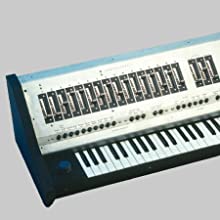
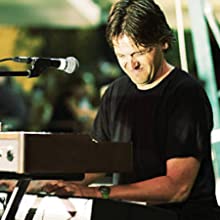
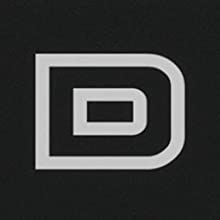

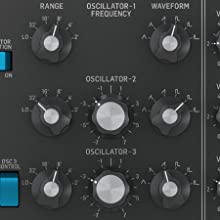
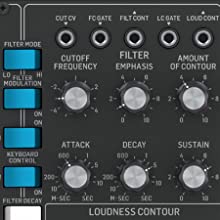
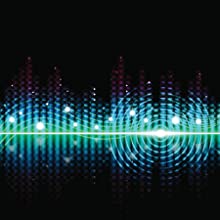
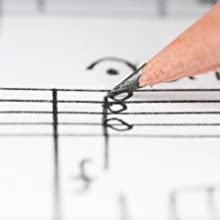

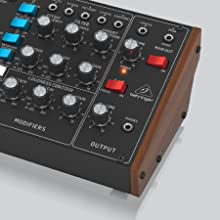
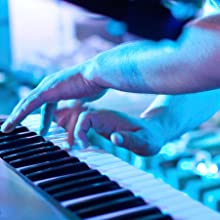

Segundo modulo que compro. suena bestial y muy buena construccin.
The bass on this thing is thumping. You won’t find a fatter bass at this price. It’s also great for leads. As someone who has owned and played many virtual analogue and software synths, nothing compares.
I’m coming from using VST instruments
This MODEL D is a monophonic synth if you are serious about it you have to have a good pair of Headphones.
I’m using this with my Novation Launchkey 37 MK3 which can generate ARP sequences and surprising rhythms
The best thing about this synth is if you can find a book/preset settings (pictures)
from the original moog MODEL D than all of the Oscillators/knobs/switches everything looks the same on the hardware’s panel and you can recreate the patches on this MODEL D.
I’m impressed just by the RAW sound when I’m using it standalone (without a PC) the ladder filter is awesome the “ext in volume” acts like the Multidrive saturation knob on the SUB37 really loving it.
When the whole unit’s experience really comes alive is when you use it with Ableton Live you can trigger the MODEL D with MIDI and you can add massive reverbs/delay/various effects you can create stunning bass patches/beefy plucks/screaming lead sounds if you are digging deeper you can even create analog drums snares hihats and weird FX sounds/chirps.
USB connection is easy plug and play it has it’s own software you can update the firmware easily etc…and my favorite thing is you don’t need an audio interface everything can be done through USB.
The only con is you can’t save patches/presets because what you dial in on the hardware has to stay as it is if you loving it and you have to take a picture with your smartphone to redial the osc/knobs/filters/etc to recall your loved sound.
Everything feels great on the hardware the moog style knobs
The unit is heavy enough not to wiggle or slip on your desk while you are twisting the knobs.
Because it is a analog synth you have to tune it with the A-440 signal generator which gives you a constant “A” note.
Close your eyes and it’s a moog.
Thanks cosmo music for still having this in stock. Worth it. Love it. Use i
Cuando sea millonario comprar el original. Mientras tanto este va bien.
A great addition to any synth collector`s armory. The fantastic return of a classic Moog synthesizer but with all the modern extras , using the same electronics of the original , all this in a solidly built unit at a fraction of the cost of an actual Moog..
Best to use a sequencer to play this device, I personally use the key step 37. Love to live jam with it.
Hi, and greetings. Completely in tune with this Module.
Close and fiddle perfect instrument/Synthesizer. Get yourself one and create a melody from the depth of controlled voltage.
Stone Thang
True to original at a fraction of the cost,versatile connections. Controls are small but useable
Potenza sonora come sulla macchina originale.
Stessa sensibilit degli oscillatori.
Buon filtro e circuiti dell’inviluppo.
Offre qualche funzione in pi rispetto alla macchina originale.
Vom Preisleistingsverhltnis kann man sagen, dass es vllig in Ordnung geht, was fr eine Qualitt angeboten wird.
It’s not quite a Moog but for the price it’s much better value. It feels better in quality to the Behringer Neutron which I also own. With three oscillators, a white noise generator, a pink noise generator, an LFO and two ADSR type filters it doesn’t leave you wanting for much.
strumento eccezionale e versatile. richiede un approccio particolare non potendo memorizzare alcun preset. ma restituisce un suono, dai bassi ai droni ai pluck, veramente ricco e “moog”. altamente consigliato.
Che dire ? Suono immortale Moog ad una frazione del prezzo. Come tutti i (semi) modulari richiede conoscenza e pratica per “domarlo” alle proprie esigenze timbriche ma i risultati sono davvero qualitativi. Sarebbe stato bello che in questa “iterazione” di Behinger fosse stato integrato un riverbero/echo integrato per dare quella spazialit al suono che al giorno d’oggi ci si potrebbe aspettare, ma sufficiente comunque utilizzare un qualunque effetto aggiuntivo, ormai gi molto comunemente in dotazione di un qualunque mixer di fascia bassa. Consigliatissimo !
Wonderful bit of kit. A bargain at 215. The price changes almost daily it seems, so it’ll be worth being patient, when buying.
A cracking entry into the world of semi-modular synthesis.
I have bought my kids toys with better build quality, no joke, but all is forgiven when you hear the sound!
Ottima “palestra” per entrare nel mondo dei sinth analogici.
Ricreare le sonorit dei gruppi musicali che ascoltavo da adolescente stata una soddisfazione unica.
Grazie a Behringer che al decimo del costo dell’originale mi ha permesso di fare un tuffo nel passato.
Ich besitze neben dem Behringer Model D auch einen Moog Minimoog. Natrlich habe ich beide Gerte zeitgleich im Einsatz. Den “echten” Moog behalte ich eigentlich nur noch wegen Haptik und Optik. Was den Sound angeht nehmen sich die Gerte kaum etwas. Was das Preis/Leistungsverhltnis angeht: Absolut unschlagbar!
Ich kann den Behringer Model D uneingeschrnkt empfehlen.
– Sound zu 100% wie beim Minimoog
– Verarbeitung stabil
– Haptik ist super
Wer sich das entgehen lsst ist selbst schuld 😉 Klare Kaufempfehlung.
The best Christmas gift ever Very rich sounds ” Really powerful Synth , very close to Moog !
I’ve got massive setup, but this addition added to the family made my setup even better.
On a technical level it’s very simple. It’s a monophonic three-oscillator synthesiser that uses real analogue circuitry to generate its sounds, so there’s no aliasing noise. It has a choice of waveforms, including several pulse waves, but it doesn’t have pulse width modulation. It has filter and amplitude modulation, but it doesn’t have ring modulation or any built-in effects, beyond a simple overdrive.
It has an external input so you can use it to process your own sounds. It also has trigger inputs for the filter and amplitude envelope and so, with the right cables, you can use it as an external filter for other synthesisers. Apart from CV/GATE it also has MIDI and USB MIDI (it’s class-compliant, so you don’t need special drivers).
There’s no arpeggiator, no multi-timbrality, no patch memories, no splittable keyboard etc. You have to tune it every so often. Original MiniMoogs are well-made but the Model D is built down to a price, in particular I’m suspicious of the MIDI ports. They’re very tight. The controls poke through holes in the front panel, but they aren’t anchored to the case, so I’m worried that eventually the soldering holding the ports onto the circuit board will break.
As with the MiniMoog the Behringer D has a limited bag of tricks, but – again, as with the MiniMoog – it sounds great, and that’s what counts. The filter has a lovely warm tone, and even with a single oscillator the Model D doesn’t sound harsh and electronic, it sounds cute and twinkly; if you turn on all three oscillators at once it sounds huge. It’s very good at deep bass noises and smooth leads. The lack of PWM makes it less suitable for strings. If you have a DAW it’s trivially easy to tweak the tuning slightly and layer several sounds on top of each other, in which case it sounds massive.
It adds a few things to the MiniMoog spec. There’s a separate LFO (you don’t have to use OSC 3), an A440 tuning oscillator, and you don’t have to physically patch the output into the input to use the overdrive effect, you just turn up the external input control. One oddity is that the filter and amp envelopes have separate gate triggers, so if you’re using CV/gate you need a way to send two gates to it if you want to use it as an external filter, not just one. The outputs are unbalanced. MIDI support is essentially note on, note off, and pitchbend. Nothing else. You have to use the knobs.
Use the knobs. The Model D is particularly useful if you have a DAW setup, but you want to add some analogue sounds. Compared to e.g. the Korg ARP Odyssey or a modular synth it’s a lot less flexible, but if you want squiggly acid noise and thwumping 1970s Parliament / Funkadelic bass tones it’s great. You can apparently chain several of them together to make a polysynth, and the box also comes with components to rackmount it, but it’s very compact as it is.
And that’s the Model D. If you have no other synthesisers, no DAW, no other equipment you might be disappointed (unless you’re a keyboard wizard – and perhaps you are – it works best as part of an ensemble). I’m also worried about its longevity, but if I was a gigging musician it would probably be cheaper to buy three of these for redundancy’s sake than a single MiniMoog.
Don’t dally, buy.
However…….
As this is old tech revisited, it also has old tech issues.
Like tuning.
Don’t get me wrong, tuning is easy to do but mine was unable to reach the pitch of A on osc 1.
To counter this I tuned the synth to ‘G’ (hold A on midi keyboard and tune to G) and the once done, used the primary tuner knob to hit pitch. First world problems eh?
Again, it is a great synth, tuning is simple – there are many vids online and behringers own is good enough in order to do this – just be aware that some, like mine, may not be perfect.
If it went bang, I would buy again.
For the price it’s hard to believe the sound it makes. Fair play to bheringher!
But
There are a lot of people I know who say should I go Model D or go Neutron. I now have both, so my advice is – if you want to play amazing lead synth solos or add overdubs to your programmed sequences, then go Model d. Think one handed keyboard solo. If you tweak twiddle and modulate and think what happens if I put this in here, think Neutron. A simplified review of course.
Awesome sound, very deep and rich bass;) love it and it won’t break your wallet:D
Ottimo rapporto qualit prezzo, spedizione e consegna affidabile e veloce
I’ve always wanted a Minimoog, but I’m more like Moog taste, Behringer budget. Luckily Behringer have decided to go all out on releasing classic synths at a great price. This is unbelievable value for money, a Minimoog (working perfectly) and sounding fantastic for less than 300 notes. I’m sure they’ve sold a buckload of these and will continue to do so for a long time to come! Now I have to save up for all their other reissues!
Brilliant better than anticipated..
Love this machine..it’s a synth what would you expect.
No good for cooking or washing
Outstanding product, especially given the price. Behringer are making some fantastic products these days.
Gorgeous sound, such a weighty, meaty analog sound, its got that magic!
The question everyone should be asking is how can Behringer sell the Model D so cheaply. This is a fun instrument to play and it’s powerful too
It lives up to the hype…..
It IS a mini Moog. Totally identical. And the best one too… A 1972 version.
I think now the stock has been used up across Europe. I got one of the few stocked and got it in two days. Not from Amazon. But they didn’t order enough likely. I would recommend you place an advanced order it will take behringer months to clear the orders I am guessing.
Already the sales of this beast have out stripped the sales of the mini Moog across its lifetime.
Note… The two optional outputs of of this synth are TRS. I recommend using the high level to a mixer or effects unit.
Midi based wheels will drive the modulation in the synth. Which is cool.